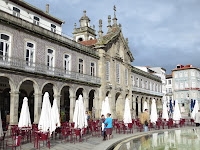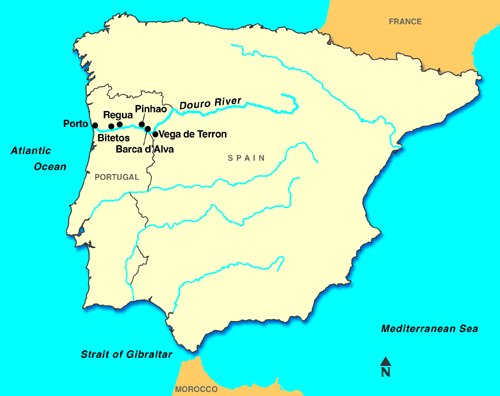We decided on Salamanca.
But on the way to Salamanca, we felt the need to stretch our legs and the walled city of Ciudad Rodrigo presented an opportunity to get in touch with our inner Napoleonic soldier-in 1810 the city fell to the French after a 24-day siege, only to be recaptured by Wellington in 1812. The walls are intact so they must have been repaired after the war. There are great views of the county side, but you mostly have to keep your eyes on the ground to avoid the dog poop. Nice looking cathedral built between 12th-14th centuries, but closed, as are most things, between 1:30 and 4:30.
Salamanca was a glorious city, the old ochre stone glistening in the failing light and lightly falling rain. Truly magnificent buildings throughout the old quarter. We didn't have nearly enough time to see everything we wanted and had to make do with seeing just the University, the plaza and a very special convent.
The University was founded in 1134, making the oldest university in Spain and the the 3rd oldest operating university in Europe. Famous students include Miguel de Cervantes, Miguel de Unamuno, St John of the Cross, Fray Luis de León, Calderón de la Barca. It has widely recognized Spanish language programs, and sometimes I dream about going to school there. I felt smarter just walking through the lecture halls and corridors. The old library is spectacularly crammed with parchments and rare manuscripts.
Note: While Fray Luis de León was teaching at Salamanca, he was imprisoned by the Inquisition. After 4 years of torture, hardship and solitary confinement, he was released and returned to the university. According to legend, upon his return to teaching, he began his first class with the words "as we were saying yesterday..."
 | |
| the library |
 |
| May be the oldest book in the world |
I think we might have left the best spot for last though. The Convent of St Claire was founded in the beginning of the 13th century as a royal convent. As such, it was richly endowed and finely decorated. When it was remodeled in the mid 16th century, the builders made a conscious decision not to destroy the original art that covered the church's ceiling. Instead, a false vaulted ceiling was built. The original murals were covered with plaster which was thought to be more sanitary. So, both the walls and ceiling were protected and not re-discovered again until 1976. They are marvelous! Unfortunately, no photographs were allowed, but if you are interested, you can see some of them at this web site.
The church was lovely, but paled in comparison with the artwork under the false ceiling.
We were the only visitors that morning and had the luxury of a private guided tour by a wonderful guide who had very understandable Spanish. As we left, we met the only non-cloistered member of the convent, a twinkle-eyed, older nun who I could relate to on an eye-to-eye basis. There was some indescribable quality to her character that Tom and I talked about long after we left the convent.


















































